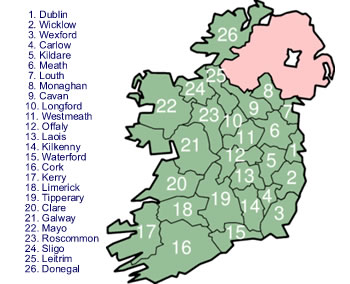Difference between revisions of "Republic of Ireland"
(→Links) |
(→Links) |
||
| Line 72: | Line 72: | ||
*[http://www.irelandgenweb.com/ Ireland GenWeb] | *[http://www.irelandgenweb.com/ Ireland GenWeb] | ||
| + | |||
| + | *[http://www.ihpc.ie/ihpc/Main/Home.asp Irish Historical Picture Company] | ||
*[http://www.rootsweb.com/~irlkik/ihm/ Ireland’s History in Maps] | *[http://www.rootsweb.com/~irlkik/ihm/ Ireland’s History in Maps] | ||
Revision as of 06:22, 15 September 2008
Counties of the Republic of Ireland
General History
Before the last ice-age, there was no Irish Sea, English Channel or North Sea, Europe was all one land mass and the fairly sparse population was of European origin . The encroaching ice pushed out most humans although one or two tribes may have held out on the West Coast of Ireland where the gulf stream raised the temperature, probably to something like Alaska's today. After the ice-age, about 10,000 years ago, the melting ice caps raised the sea level and created the present islands which were populated by European Celts who were gradually pushed westward by fresh influxes from Europe (mainly Germanics) and Scandinavia. Ireland in particular received quite a lot of Spanish. Trade by sea flourished so there were other additions to the gene pool, e.g. Viking, and later Spanish.
The island of Ierne (Ireland) was settled by a Milesian race, who came from Scythia (Middle East) by way of Spain, and established the Kingdom of Tara about 500 BC. The supremacy of the Ardri (High King) of Tara was acknowledged by eight lesser kingdoms (Munster, Connaught. Allech, Auriel, Ulidea, Meath, Leinster and Ossory) ruled by descendants of the eight sons of Miled.
Although little is known concerning the earliest inhabitants of Ireland, there are many traces of Neolithic man throughout the island. In the later Bronze Age a Celtic race of Goidels (Gaels) appears to have invaded the island and in the early Iron Age Brythons from South Britain effected settlements in the South East, whilst Picts from North Britain established similar settlements in the North. Towards the close of the Roman occupation of Britain (they never got to Ireland), the dominant tribe in the island was that of the Scoti, who afterwards established themselves in Scotland. Gypsies, a nomadic race, originally from India, are also well represented. The overall population remained sparse, under 3 million until the 20th century
With the separation of Britain, in the reign of Henry Vlll, from the Roman Catholic Church, Spain aggressively attempted to isolate England and sought to strengthen ties with the rest of Europe, including Ireland which remained predominately RC, culminating in a disastrous attempted invasion of England in 1588. The Armada came to grief after being forced through the English Channel, into the North Sea and rounding Scotland. It is believed that hundreds of Spanish sailors got ashore on the Irish coast and disappeared inland.
Links
- Clogher Historical Society promotes local history in the counties of Fermanagh, Monaghan, South Tyrone and parts of South Donegal and West Louth
- Failte Romhat includes many online records
- Irish Ancestors the website of The Irish Times
- Ireland Genealogy Projects covers most counties
- Irish-American Web Ring several web rings connected together with numerous links about Ireland, its history and its culture
- Irish Roots covers most counties
Back to World Index Page
